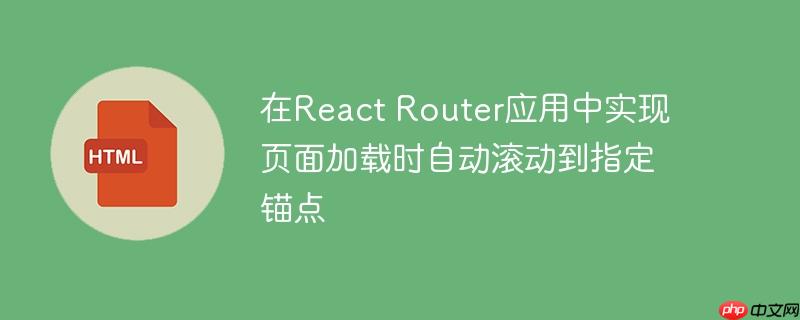
在传统的网页开发中,当URL包含一个哈希片段(如mySite.com/#contact)时,浏览器会尝试在页面加载完成后自动滚动到具有匹配id属性的HTML元素。然而,在基于React Router等库构建的单页应用(SPA)中,这一行为常常失效。
其核心原因在于:
因此,我们需要一种机制,在目标DOM元素确实存在于页面上之后,再通过编程方式触发滚动。
解决这个问题的关键在于,在React组件挂载(即其DOM元素已渲染到页面上)之后,检查URL中的哈希片段,并手动执行滚动操作。这可以通过React的生命周期方法或Hooks来实现。
对于类组件,componentDidMount是执行此逻辑的理想位置。它在组件首次渲染到DOM后立即调用。
import React, { Component } from 'react';
import { BrowserRouter, Routes, Route } from 'react-router-dom';
// 假设这是你的App组件
class App extends Component {
componentDidMount() {
// 获取URL中的哈希片段(例如,"#contact")
const urlHash = window.location.hash;
// 检查哈希是否存在且非空
if (urlHash.length > 0) {
// 移除哈希前的"#",获取元素ID(例如,"contact")
const elementId = urlHash.substring(1);
// 根据ID获取DOM元素
const element = document.getElementById(elementId);
// 如果元素存在,则滚动到该元素
if (element) {
element.scrollIntoView({ behavior: 'smooth' }); // 添加平滑滚动效果
}
}
}
render() {
return (
<div className="App">
<NavBar />
<Home />
<Contact /> {/* 假设Contact组件内部有一个id="contact"的元素 */}
</div>
);
}
}
// Contact组件示例
const Contact = () => {
return (
<div id="contact" className="Contact">
<h2>联系我们</h2>
<p>这是联系我们区域的内容。</p>
</div>
);
};
// Home组件示例
const Home = () => {
return (
<div className="Home" style={{ height: '800px', background: '#f0f0f0', display: 'flex', justifyContent: 'center', alignItems: 'center' }}>
<h1>首页内容</h1>
</div>
);
};
// NavBar组件示例
const NavBar = () => {
return (
<nav style={{ padding: '20px', background: '#eee' }}>
<a href="#home" style={{ marginRight: '15px' }}>首页</a>
<a href="#contact">联系我们</a>
</nav>
);
};
// 你的根组件
const Root = () => {
return (
<BrowserRouter>
<Routes>
<Route path="/" element={<App />} />
</Routes>
</BrowserRouter>
);
};
export default Root;对于现代React应用,函数组件和Hooks是更推荐的方式。useEffect Hook可以模拟componentDidMount的行为。
import React, { useEffect } from 'react';
import { BrowserRouter, Routes, Route, useLocation } from 'react-router-dom';
// 假设这是你的App组件
const App = () => {
const location = useLocation(); // 获取当前路由信息
useEffect(() => {
// location.hash 包含了URL的哈希片段
const urlHash = location.hash;
if (urlHash.length > 0) {
const elementId = urlHash.substring(1);
const element = document.getElementById(elementId);
if (element) {
element.scrollIntoView({ behavior: 'smooth' });
}
}
}, [location.hash]); // 依赖项为location.hash,确保在哈希变化时也能触发
return (
<div className="App">
<NavBar />
<Home />
<Contact /> {/* 假设Contact组件内部有一个id="contact"的元素 */}
</div>
);
};
// Contact组件示例 (同上)
const Contact = () => {
return (
<div id="contact" className="Contact">
<h2>联系我们</h2>
<p>这是联系我们区域的内容。</p>
</div>
);
};
// Home组件示例 (同上)
const Home = () => {
return (
<div className="Home" style={{ height: '800px', background: '#f0f0f0', display: 'flex', justifyContent: 'center', alignItems: 'center' }}>
<h1>首页内容</h1>
</div>
);
};
// NavBar组件示例 (同上)
const NavBar = () => {
return (
<nav style={{ padding: '20px', background: '#eee' }}>
<a href="#home" style={{ marginRight: '15px' }}>首页</a>
<a href="#contact">联系我们</a>
</nav>
);
};
// 你的根组件
const Root = () => {
return (
<BrowserRouter>
<Routes>
<Route path="/" element={<App />} />
</Routes>
</BrowserRouter>
);
};
export default Root;在函数组件的useEffect中,我们使用了useLocation Hook来获取当前的location对象,其中包含了hash属性。将location.hash作为useEffect的依赖项,可以确保不仅在组件首次挂载时,而且在URL的哈希部分发生变化时(例如,用户在同一页面内点击了不同的锚点链接),滚动逻辑也能被触发。
在React Router构建的单页应用中实现页面加载时自动滚动到指定锚点,需要我们跳出React Router的路由管理范畴,转而利用React组件的生命周期(或Hooks)结合原生的DOM操作API。通过在组件挂载后检查window.location.hash并使用document.getElementById().scrollIntoView(),我们可以有效地解决这一常见的导航挑战,为用户提供无缝且符合预期的页面滚动体验。
以上就是在React Router应用中实现页面加载时自动滚动到指定锚点的详细内容,更多请关注php中文网其它相关文章!

每个人都需要一台速度更快、更稳定的 PC。随着时间的推移,垃圾文件、旧注册表数据和不必要的后台进程会占用资源并降低性能。幸运的是,许多工具可以让 Windows 保持平稳运行。

Copyright 2014-2025 https://www.php.cn/ All Rights Reserved | php.cn | 湘ICP备2023035733号